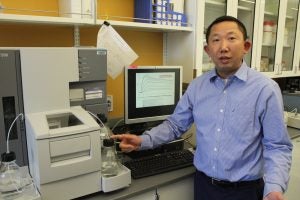URI Pharmacy Assistant Professor Deyu Li leads study funded by NIH

A person unknowingly exposed to a carcinogen may live for years — even decades — before a cancer diagnosis is made, giving tumors time to grow and the disease time to develop, making treatment more difficult or even impossible.
But what if people knew what toxins they’ve been exposed to in their lifetimes long before a cancer has begun to form? They could be screened for the cancers those carcinogens cause and have a much better chance of tackling the disease before it turns incurable.
URI College of Pharmacy Assistant Professor Deyu Li is trying to give people exactly that chance, leading a study to identify the mutational spectra of environmental toxins. Funded by the $2.1 Million ONES (Outstanding New Environmental Scientist) Award from National Institute of Environmental Health Sciences, one of the 27 institutes and centers of the National Institutes of Health. The five-year study examines the mutational spectra of human carcinogens.
“It’s often a very long time between exposure to a carcinogen and a diagnosis of cancer,” Li said. “By then, it’s often too late for the patients. But we can help them know way earlier than that. By identifying the damaging patterns to the genome, we could tell people they are at risk, which would increase the chances of preventing tumorigenesis or catching a tumor when it’s very small. They’ll have a better chance of living longer and living a better life.”
By collaborating with Dr. Bongsup Cho’s lab in the same department, Li’s study begins with 4-aminobiphenyl and amino-alpha-carboline. The former is the only known chemical that can cause human bladder cancer and the latter is a carcinogen that is formed in well-done cooked meat, diesel gas exhaust and tobacco smoke. He hopes to identify mutational spectra of the two toxins, with the goal of eventually mapping many other carcinogens. Once the mutational spectra are identified, people who have their genomes sequenced can search for the mutational spectra and know to watch for specific cancers as they age.
“We should get to know these carcinogens on a much deeper level,” Li said. “We’re trying to focus on one chemical and even on one DNA lesion at a time and find the exact mutational patterns. Hopefully in the end, we can get more and more spectra and help solve environmental and disease-related problems.”
